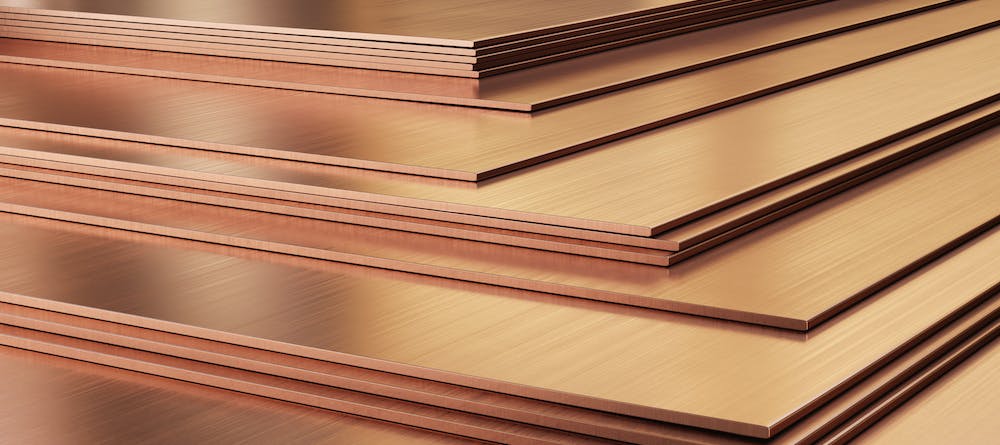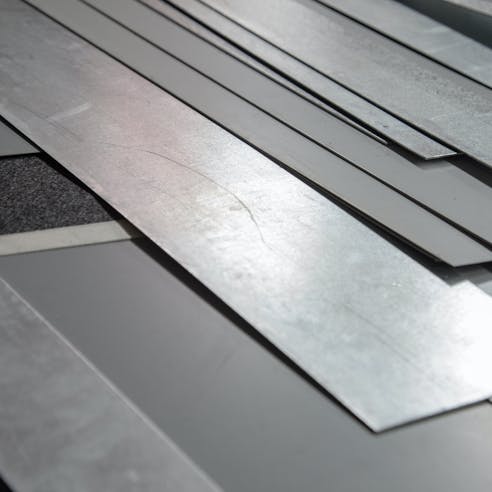Bronze Sheet Metal Fabrication
Upload your CAD files to get an instant online bronze fabrication quote on custom-formed sheet metal prototypes and production parts. Lead times as fast as days and free standard shipping on all US orders.

About Bronze Sheet Metal Fabrication
Bronze is made by mixing copper with tin plus some additional alloying elements that enhance certain characteristics. Bronze for sheet metal fabrication must have high cold-workability and ideally should not work-harden too readily. Some bronze sheet materials tend to work-harden during forming and as such require annealing cycles to prevent cracks or tears during bending operations.
Bronze has many different uses in sheet metal components. It finds use in a range of industries such as the marine, medical, and electrical trades. This is in part due to its excellent corrosion resistance, formability, and anti-microbial properties.
Bronze 220
This material is known as commercial bronze. Despite its name, the use of zinc as the main alloying element technically makes this a type of brass. It has excellent formability, though, so it is ideal for sheet metal applications. The zinc content allows for more cold working cycles without the need for annealing. Applications can include electrical fittings, springs, and marine components.
| Tensile Strength, Yield (MPa) | Fatigue Strength (MPa) | Elongation at Break (%) | Hardness (Brinell) | Density (g/cm^3) |
|---|---|---|---|---|
Tensile Strength, Yield (MPa) 55.2 - 117 | Fatigue Strength (MPa) N/A | Elongation at Break (%) 49 | Hardness (Brinell) 92 | Density (g/cm^3) 8.8 |
Bronze 510
This alloy is known as phosphor bronze due to the inclusion of a small amount of phosphorus. It has high yield strength when compared to other bronze alloys. This grade of bronze can be soldered, brazed, and arc-welded. Its applications include perforated sheets and electrical fasteners.
| Tensile Strength, Yield (MPa) | Fatigue Strength (MPa) | Elongation at Break (%) | Hardness (Brinell) | Density (g/cm^3) |
|---|---|---|---|---|
Tensile Strength, Yield (MPa) 131 - 200 | Fatigue Strength (MPa) N/A | Elongation at Break (%) 48 - 62 | Hardness (Brinell) 68 - 79 | Density (g/cm^3) 8.86 |
Finishes
Xometry offers a range of surface finishes applicable to bronze sheet metal. These can include metal plating or chemical coatings that prevent oxidation.
Metal plating: Bronze can be plated with a wide range of metals to increase its corrosion resistance, increase wear resistance, or improve product aesthetics. Sheet metal bronze accepts both electroplating and electroless plating, usually in chrome or nickel. Consult information on Xometry finishes to learn more about the benefit of each type of coating.
Clear Coating: Some manufacturers prefer to retain bronze’s natural appearance for its warm luster. Clear coats provide the surface with additional protection while not altering its coloration.

Cost-saving Design Tips
Bronze for sheet metal fabrication can be a costly material, so its use must be optimized as much as possible.
DFM: Cost minimization begins at the design phase. Apply design-for-manufacturing (DFM) principles from the start in order to minimize overall fabrication expenditures. For example, allow for bend reliefs near sharply bent corners to ensure no cracks form. This is especially important for bronze as many alloys can work-harden during bending processes. Review the Xometry sheet metal design guide to learn how to achieve the required functionality using common sheet metal fabrication techniques.
Choose the right alloy: Bronze for sheet metal fabrication can work harden during bending. If a part requires multiple bends close to each other it may be better to use an alloy that does not work-harden as quickly, such as Bronze 220, which hardens less quickly than higher zinc alloys like Bronze 240 and 260.

